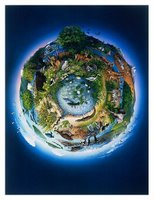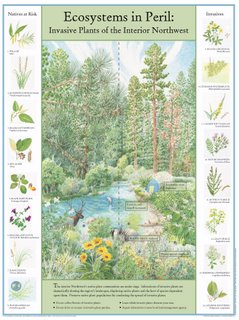Interesting artist: Good browsing for natural history, artwork, poetry.
Weird certification -- good/evil logo. Go figure.
Rigor Vitae: Life Unyielding
Random Notes-- Art, Politics, Poems, Music of Interest-- Including Good Nature Publishing New Work
Thursday, March 30, 2006
Eyesight -- a poem by A. R. Ammons
Eyesight
It was May before my
attention came
to spring and
my word I said
to the southern slopes
I've
missed it, it
came and went before
I got right to see:
don't worry, said the mountain,
try the later northern slopes
or if
you can climb, climb
into spring: but
said the mountain
it's not that way
with all things, some
that go are gone
A.R. Ammons
It was May before my
attention came
to spring and
my word I said
to the southern slopes
I've
missed it, it
came and went before
I got right to see:
don't worry, said the mountain,
try the later northern slopes
or if
you can climb, climb
into spring: but
said the mountain
it's not that way
with all things, some
that go are gone
A.R. Ammons
Tuesday, March 28, 2006
Business' Roots in Biodiversity

(Art by S. Duranceau)
The Ecology of Commerce was written by Paul Hawken a decade ago. Do we really need a review about these basic connections between business and our life force?
Help me! We live on one planet. Biodiversity is the basis to life, to our wealth (the various kinds -- not just economic) and happiness.
People are alive. People create business.
Any questions about the loop? The basis of life, of our civilization, and the businesses running today is rooted in biodiversity.
Biodiversity Guide
From World Changing
Basta/
TSC
Sunday, March 19, 2006
My Contribution to Climate Change: Traveling
We need to begin a rapid shift away from petrol to reduce Carbon Dioxide (CO2) levels in the US. We Americans make up 5% of the world's population, and contribute 25% of the CO2.
I have been thinking of ways to change my CO2 exhaust, and figured a good starting point would be to simply calculate it.
I flew back to Boston from Seattle on business, then rented a car and drove to see my family in Vermont last week. We stayed at a downtown hotel, I took the Boston T or walked everywhere in Boston.
I found a site to help me figure out travel costs in CO2 --just to see what my contribution to climate change was in 8 days.
The site I used is from Native Energy -- see link below.
Seattle to Boston
Your travel CO2 emissions results
Auto Travel: 453 lbs CO2 0.2 Tons CO2
Air Travel: 3105 lbs CO2 1.6 Tons CO2
Rail Travel: 0 lbs CO2 0 Tons CO2
Bus Travel: 8 lbs CO2 0 Tons CO2
Accommodations: 282 lbs CO2 0.1 Tons CO2
Total: 3847 lbs CO2 2 Tons CO2
Stunning!
Calculator at Native Energy
I have been thinking of ways to change my CO2 exhaust, and figured a good starting point would be to simply calculate it.
I flew back to Boston from Seattle on business, then rented a car and drove to see my family in Vermont last week. We stayed at a downtown hotel, I took the Boston T or walked everywhere in Boston.
I found a site to help me figure out travel costs in CO2 --just to see what my contribution to climate change was in 8 days.
The site I used is from Native Energy -- see link below.
Seattle to Boston
Your travel CO2 emissions results
Auto Travel: 453 lbs CO2 0.2 Tons CO2
Air Travel: 3105 lbs CO2 1.6 Tons CO2
Rail Travel: 0 lbs CO2 0 Tons CO2
Bus Travel: 8 lbs CO2 0 Tons CO2
Accommodations: 282 lbs CO2 0.1 Tons CO2
Total: 3847 lbs CO2 2 Tons CO2
Stunning!
Calculator at Native Energy
Native Plants People Back Off! Burpee Prez says

From Sunday New York Times Editorial Page 3/19/2006:
George Ball writes that friends of native plants have gone too far-- calling us "botanical xenophobes." You can almost here him say "plant Nazis."
Never mind the $137 billion invasives cost taxpayers in the US, George.
Let's forget about the native animals crowded out when their native plant habitat is displaced by thick thorny aliens from Himalayas.
Is this essay by a leading seed company an indicator we nativistas are having some effect in making nurseries and seed companies stop bad practices?
Better to have Mr Ball join native plant friends of mine who have pulled butterfly bush out of river banks nearby.
If Burpee company's role in careless promotion of "any seed anywhere" mentality, shouldn't a portion of their profits go to paying for the eradication and prevention plans of every state in the country?
Just ask your local fish and game agency how much has been lost to loosestrife, for starters.
Native plants connect people to our fellow birds and bees and habitats they need. The seed and nursery industries should join forces with their green brothers and sisters on growing right plants in the right place. There is enough work to do together: growing native canopies in cities to encourage a cooler planet and lower CO2.
Read on:
Op-Ed Contributor
Border War
By GEORGE BALL
Published: March 19, 2006
Warminster, Pa.
THE horticultural world is having its own debate over immigration, with some environmentalists warning about the dangers of so-called exotic plants from other countries and continents "invading" American gardens. These botanical xenophobes say that a pristine natural state exists in our yards and that to disturb it is both sinful and calamitous. In their view, exotic plants will swallow your garden, your neighbors' gardens and your neighbors' neighbors' gardens until the ecosystem collapses under their rampant suffocating growth.
If anything suffocates us, though, it will be the environmentalists' narrowmindedness. Like all utopian visions, their dream beckons us into a perfect and rational natural world where nothing ever changes — a world that never existed and never will.
Native plants are the survivalists of the botanical world, and in the appropriate settings — wilderness areas, home and botanical gardens, public parks and sidewalks — they bless us with their beauty and awe us with their tenacity. Our lives would be poor and grim without the strawberry, cranberry, columbine and trillium. They've always been here, in the same way that Native Americans have been; only their arrival and settlement are more ancient.
Their presence illustrates a geologic time, about 8,000 years ago, when the glaciers receded and unimaginably vast deluges swallowed the surface of the future United States — an airplane ride over the Midwest reveals enormous lakes formed by even larger melted ice masses. As the landscape changed, the botanical world sorted itself out, leaving us with the hardy "natives." (It should be noted, though, that many plants now considered natives — like sycamores, magnolias and cinnamon — arrived from other continents, just as we did. They are products of adaptation.)
Like human survivalists, natives are also subject to exploitation by the horticultural equivalent of radical fundamentalists. The anti-exotics argue that gardens should be populated exclusively by native plants, as if the exotics were trying to enter the flower bed illegally. The consequences of such a stand could be dire. Should we eat no onions or garlic, apples or lemons; feast our eyes on no magnificent tulips or roses — all exotics of Eurasian origin? Should Asians not enjoy their distinctive peppers, tomatoes, beans, squash, sunflowers and corn — all from the Americas?
Indeed, the world's most popular root crop, potatoes, started life as a staple of the Andean people and achieved its first international fame as a slave food. By the time it reached France, the "earth apple" was a delicacy likened to truffles; their flowers were featured in tiaras of court ladies. Exotic indeed.
Should we deprive ourselves of petunias, begonias, impatiens and hollyhocks — not a one of them "native"? Must we, on pain of being cast out of the garden as horticultural pariahs, deny the elephant his peanuts? This wouldn't be merely ridiculous. It would compare with the denial of human immigration on grounds that certain ethnic groups breed in numbers "too prolific" for the existing elite to tolerate. Imagine, then, a horticultural ruling class. No "invasives" need apply: let the lily find another valley. Such prohibitions of exotic plant species demonstrate only an elitist snobbery that is as dangerous to a free society as it is to a free botany.
No one, and certainly no gardener, grows truly destructive invasive plants in his garden. The devastating kudzu in the South, star thistle in the West and purple loosestrife in the East were accidental introductions from Asia, most often mixed with the feed and bedding of livestock. Yet the pro-native, anti-exotic partisans also wish us to stop enjoying the charms of harmless and beautiful plants like Queen Anne's lace, yarrow and chicory. Aside from requiring a bit of weeding, exotics are safe as milk, unless one considers gardening a chore rather than a passionate hobby. If so, forget the forget-me-nots.
Let's welcome, as spring arrives tomorrow, as many huddled masses of flowers, herbs and vegetables as can fit in our unique melting pot of a nation, unrivaled in its tradition of lush diversity and freedom to grow rampantly.
George Ball, a former president of the American Horticultural Society, is the president of the seed and plant company W. Atlee Burpee & Company.
NY Times Editorial Page http://www.nytimes.com/2006/03/19/opinion/19ball.html
Subscribe to:
Posts (Atom)